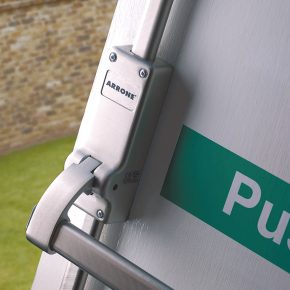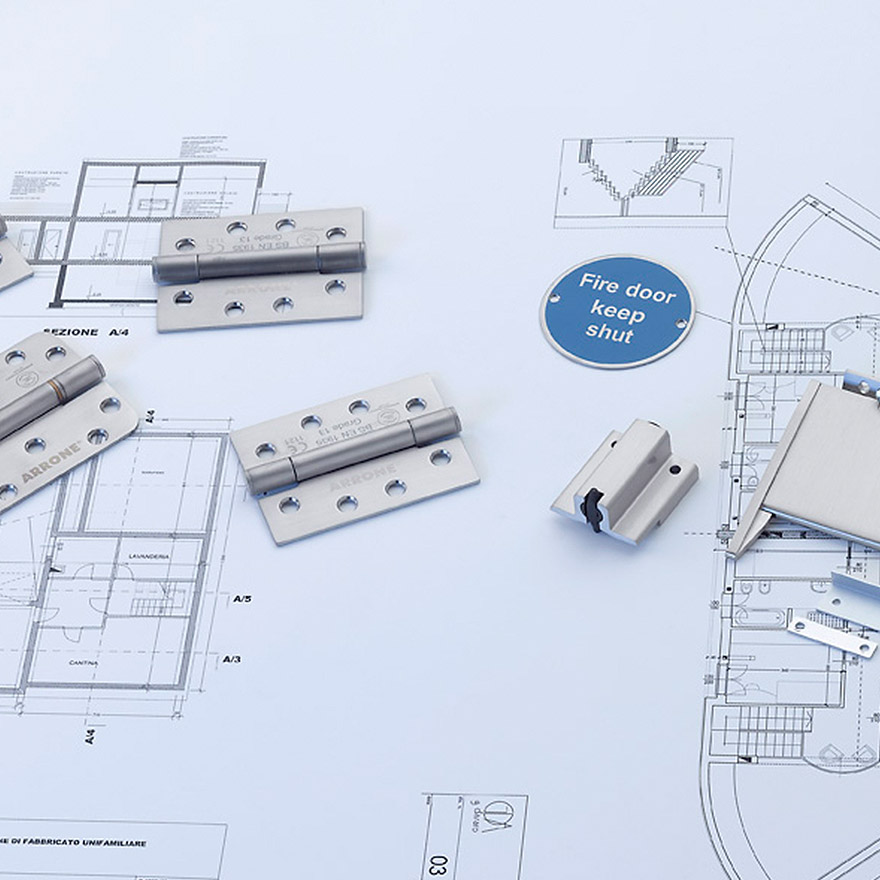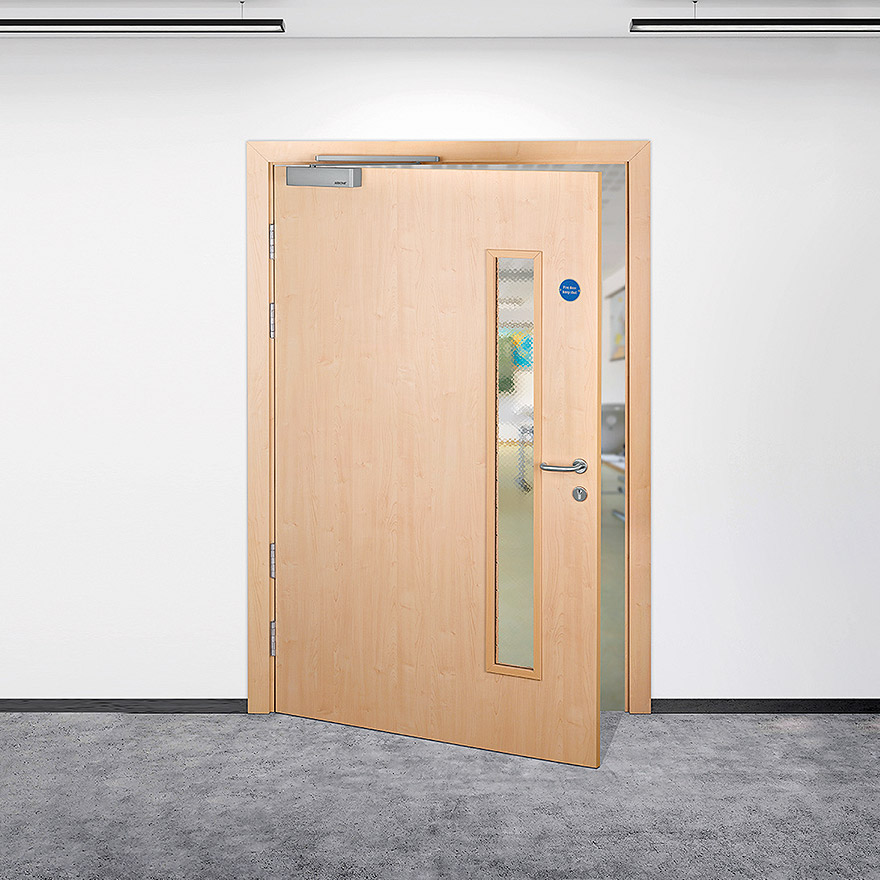
HOPPE: Fire door FAQs – A guide to fire and escape door hardware
HOPPE (UK) shares some of the questions that its technical teams are asked about fire doors and offers advice for specifying compliant door hardware in public buildings…
Can you turn any door into a fire door?
No, a fire door is designed to withstand fire for a set period of time, and it must have fire test evidence to prove this performance. This will usually be a certificate of performance, showing that the door can withstand fire for a certain length of time.
Fire doors have a minimum fire rating of 30 minutes (FD30), but some steel fire doors can achieve 240 minutes of fire resistance (FD240).
What hardware do I need?
There are three pieces of operational hardware that are critical to a fire door’s performance: hinges, door closing devices and locks. In a fire, these products help to close and secure the doors in the frame for a period of time to allow intumescent protection in the frame to expand and fill the gaps around the door.
To conform to EN1154, the smallest door closer that can be used on a fire door is a size 3. The heavier the door, the more powerful the closer must be. The smallest size 3 is up to 60kg and 950mm wide and the largest size 6 up to 120kg and 1400mm wide.

What is panic and emergency exit hardware and do I need it?
Depending on where the door is located, you may need panic or emergency exit hardware. The type of hardware required will depend on the building’s type, application, its occupation levels, and where the door is in the building. For fire doors on an escape route, panic or emergency exit hardware is mandatory.
Emergency exit hardware is mainly used in buildings where users are familiar with exit routes, such as offices, and are not accessible to the public. Devices for these doors could be a simple push pad type device or a lever handle operating a mortice escape lock or nightlatch.
Panic hardware is used when the general public has access to the building and may not be familiar with the exit routes, for example in hospitals and community buildings. This applies to any room with a capacity of over 60.
Any doors in areas that are accessible to the public must have a device fitted that is operable by a horizontal bar that covers at least 60% of the overall door width. As well as being easier to see and use, it also adds another layer of safety functionality in the event of an emergency

What signs do I need for my fire door?
There are three types of signs for use on fire doors:
– Fire Door Keep Shut – for self-closing doors used for passage of people
– Fire Door Keep Locked – for doors which are locked shut and only used occasionally
– Automatic Fire Door Keep Clear – for doors which are held open using a legal device or are swing-free but revert to self-closing when a fire alarm is activated
I’m about to refurbish my building, what do I need to consider?
If replacing any fire door hardware, the new components must be equal to or better than the fire/mechanical performance of the door.
To tell if a product is ‘like for like’, look at the tested elements and the certification for the products. Check what type of door the ironmongery is tested for use on. A product that has been fire tested for use on an FD30 is not necessarily suitable for use on an FD60 and vice versa (without prior testing on that type of door).
Remedial work should not include any removal of intumescent materials from the door unless damaged. Any replacement of hardware intumescent kits should be the exact same material, size and thickness.
Any works should be carried out by a competent person and should be signed and countersigned by the tradesperson completing the installation and the fire door inspector. All materials used should be clearly listed and a certification file compiled for future reference.

How often should I check and maintain fire door hardware?
A fire door needs regular maintenance and checks to prevent and address issues that could impact performance. There is not a specific frequency stated within law, but HOPPE (UK) recommends at least once per year.
When inspecting the ironmongery on a fire door, here are some key things to check:
– CE marked hinges are firmly fixed with no missing screws
– Seals are fitted at the top and sides of the door
– The door closer shuts the door firmly into the latch from any position
If in doubt about any fire door hardware, consult with the original door manufacturer or contact one of HOPPE (UK)’s Guild of Architectural Ironmongers (GAI) qualified experts for advice on 01902 484 400.
Latest news

29th April 2025
Senior pledges to ‘bee’ part of the solution with new biodiversity initiative
Senior Architectural Systems has installed its first on-site beehive, marking another step forward in its commitment to sustainability and biodiversity.
Posted in Articles, Building Industry News, Building Products & Structures, Building Services, Curtain Walling, Doors, Glass, Glazing, Innovations & New Products, news, Restoration & Refurbishment, Retrofit & Renovation, Sustainability & Energy Efficiency, Walls, Windows
29th April 2025
West Fraser range delivering key benefits for South-East carpentry company
An experienced carpenter and building site manager who has recently set up his own company is using high performance panel products from the West Fraser range.
Posted in Articles, Building Industry News, Building Products & Structures, Building Systems, Case Studies, Garden, Restoration & Refurbishment, Retrofit & Renovation, Sustainability & Energy Efficiency, Timber Buildings and Timber Products
29th April 2025
CPD Courses Available Online From Ecological Building Systems
Ecological Building Systems, a leading supplier of natural building products for sustainable construction, has revealed its comprehensive CPD programme for the year ahead.
Posted in Articles, Building Industry Events, Building Industry News, Building Products & Structures, Building Services, Continuing Professional Development (CPD's), Information Technology, Innovations & New Products, Insulation, Restoration & Refurbishment, Retrofit & Renovation, Seminars, Sustainability & Energy Efficiency, Training, Walls, Waste Management & Recycling
29th April 2025
WindowBASE launches new prospect databases at FIT Show
Visit WindowBASE at the FIT Show to see first-hand how it helps companies find new customers – the company is launching an easy-to-use, intuitive platform on Stand G16 at the NEC Birmingham from 29th April – 1st May.
Posted in Articles, Building Industry Events, Building Industry News, Building Products & Structures, Building Services, Doors, Exhibitions and Conferences, Glass, Glazing, Information Technology, Innovations & New Products, Posts, Publications, Research & Materials Testing, Restoration & Refurbishment, Retrofit & Renovation, Windows
 Sign up:
Sign up: